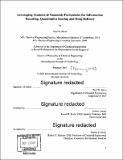| dc.contributor.advisor | Robert Langer. | en_US |
| dc.contributor.author | Bisso, Paul W. (Paul William) | en_US |
| dc.contributor.other | Massachusetts Institute of Technology. Department of Chemical Engineering. | en_US |
| dc.date.accessioned | 2018-05-23T16:30:29Z | |
| dc.date.available | 2018-05-23T16:30:29Z | |
| dc.date.copyright | 2017 | en_US |
| dc.date.issued | 2018 | en_US |
| dc.identifier.uri | http://hdl.handle.net/1721.1/115691 | |
| dc.description | Thesis: Ph. D., Massachusetts Institute of Technology, Department of Chemical Engineering, February 2018. | en_US |
| dc.description | Cataloged from PDF version of thesis. "February 2017." Handwritten on title page "February 2018." | en_US |
| dc.description | Includes bibliographical references. | en_US |
| dc.description.abstract | It is both uncontroversial and unassailable to assert that small things can often go where big things cannot. It is similarly prosaic to note that at smaller length scales, matter behaves differently than at larger length scales. This thesis exploits these intuitive and simple axioms to yield advances in three independent lines of enquiry: (i) robust and practically accessible encoding of information within microparticles, (ii) rapid, quantitative sensing of hydrophobic colloids and (iii) immunologically-focused drug delivery. Specifically, upconversion nanocrystals are used as the foundation of a novel spatial-spectral patterning motif to produce polymer microparticles with unique, decodable identities. With large single-particle encoding capacities (>10-⁶), an ultralow decoding false alarm rate (<10-⁹), and pronounced insensitivity to both particle chemistry and harsh processing conditions, this architecture enables practical deployment of encoded microparticles in applications with orthogonal requirements, including multiplexed bioassays and covert labeling of objects and packaging for anti-counterfeiting. Next, the large specific surface area of nanoscale objects is exploited by a family of zwitterionic, surfactant-like molecular rotors to develop a broadly applicable tool for sensitive, quantitative, and accessible nanoscale metrology. This tool is shown to address multiple challenges in nanometrology of self-assembled structures, including (i) quantification of surfactant adsorption isotherms on metal oxide surfaces, (ii) determination of self-assembly onset concentration, and (iii) high-throughput readout of drug delivery nanoparticle mass concentration. Finally, the combination of small size and large interfacial area was exploited to design nanoscale formulations for (i) ex vivo delivery to human neutrophils, a significant element of the innate immune system and (ii) targeted delivery of therapeutics to the asthmatic lung. | en_US |
| dc.description.statementofresponsibility | by Paul W. Bisso. | en_US |
| dc.format.extent | 228 pages | en_US |
| dc.language.iso | eng | en_US |
| dc.publisher | Massachusetts Institute of Technology | en_US |
| dc.rights | MIT theses are protected by copyright. They may be viewed, downloaded, or printed from this source but further reproduction or distribution in any format is prohibited without written permission. | en_US |
| dc.rights.uri | http://dspace.mit.edu/handle/1721.1/7582 | en_US |
| dc.subject | Chemical Engineering. | en_US |
| dc.title | Leveraging features of nanoscale particulates for information encoding, quantitative sensing and drug delivery | en_US |
| dc.type | Thesis | en_US |
| dc.description.degree | Ph. D. | en_US |
| dc.contributor.department | Massachusetts Institute of Technology. Department of Chemical Engineering | |
| dc.identifier.oclc | 1036985760 | en_US |
